Personal Learning Environment & PL Network
Stormboard - Online Brainstorming and Planning. Add a sticky note and post it online with dot voting.
The Modern Professional Learner’s Toolkit – Modern Workplace Learning Magazine. There is a lot of interest in the behaviour of the Modern Learner, but in the context of work it is more appropriate to talk about the Modern Professional Learner.
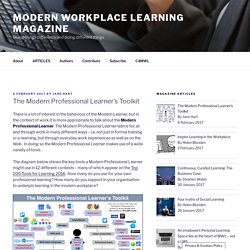
The Modern Professional Learner learns for, at and through work in many different ways – i.e. not just in formal training or e-learning, but through everyday work experiences as well as on the Web. In doing so the Modern Professional Learner makes use of a wide variety of tools. The diagram below shows the key tools a Modern Professional Learner might use in 12 different contexts – many of which appear on the Top 200 Tools for Learning 2016. How many do you use for your own professional learning? How many do you support in your organisation to underpin learning in the modern workplace? A Personal Learning Space lies at the heart of the Modern Professional Learner’s Toolkit. Web browsers are essential to get the most out of the Web.
News readers let an individual subscribe to and aggregate posts from blogs and web feeds.
Professional ecosystem. How do you stay current, relevant and up-to-date with the new technologies in education?
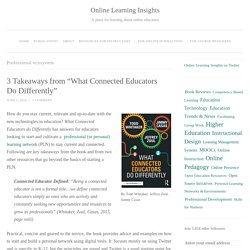
What Connected Educators do Differently has answers for educators looking to start and cultivate a professional (or personal) learning network (PLN) to stay current and connected. Following are key takeaways from the book and from two other resources that go beyond the basics of starting a PLN. Connected Educator Defined: “Being a connected educator is not a formal title…we define connected educators simply as ones who are activity and constantly seeking new opportunities and resources to grow as professionals” (Whitaker, Zoul, Casas, 2015, page xxiii) Practical, concise and geared to the novice, the book provides advice and examples on how to start and build a personal network using digital tools.
It focuses mostly on using Twitter and is specific to K-12, but the principles are sound and Twitter is a good starting point for learning how to connect and build a network. 1. 2.
Degreed For Me. The Future of Work and Learning 1: The Professional Ecosystem. “Each of us is the center of the universe.

So is everyone else.” e e cummings. Off the record. In case you missed it, Sylvia Duckworth released another of her wonderful Sketchnotes last week.
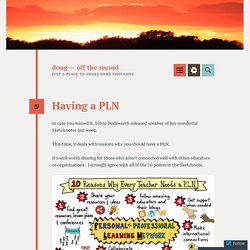
This time, it deals with reasons why you should have a PLN. It’s well worth sharing for those who aren’t connected well with other educators or organizations. I strongly agree with all of the 10 points in the Sketchnote. Once you do have that “PLN”, whether you call the P Personal or Professional, it’s equally important that you work it. As we tell our students, just because it’s on the internet doesn’t necessarily make it true. It’s also important to give back.
Lehre und Wissenschaft 2.0 » Tools. Das Tool-Portfolio gibt einen Überblick über die Werkzeuge, die für die Lehre und Wissenschaft an der Freien Universität Berlin geeignet sind ».
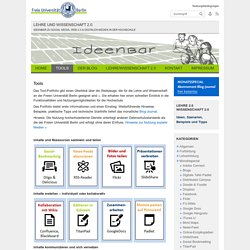
Sie erhalten hier einen schnellen Einblick in die Funktionalitäten und Nutzungsmöglichkeiten für die Hochschule. Das Portfolio bietet erste Informationen und einen Einstieg.
Lehre und Wissenschaft 2.0 » Tools. Models For Designing Your Personal Learning Environment. A personal learning environment (PLE) is a solution for keeping up with the rapid pace of knowledge change.

Some say it is a concept, while others say it is a technology.
8 Steps to Developing a Personal Learning Network. The Workscape, a learning platform for corporations. The question is not, “Do you need help?” The question is: “What kind of help do you need?”
Personal Learning Networks are the collections of people and information resources (and relationships with them) that people cultivate in order to form their own public or private learning networks — living, growing, responsive sources of information, support, and inspiration that support self-learners.
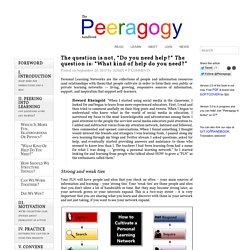
Howard Rheingold: “When I started using social media in the classroom, I looked for and began to learn from more experienced educators. First, I read and then tried to comment usefully on their blog posts and tweets. When I began to understand who knew what in the world of social media in education, I narrowed my focus to the most knowledgeable and adventurous among them.
I paid attention to the people the savviest social media educators paid attention to. I added and subtracted voices from my attention network, listened and followed, then commented and opened conversations.
Cybraryman Internet Catalogue. Absorbing complexity with PKM. Have you ever heard of the Law of Requisite Variety?
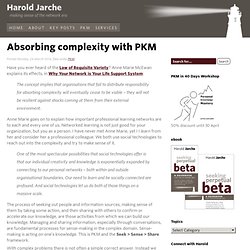
Anne Marie McEwan explains its effects, in Why Your Network is Your Life Support System: The concept implies that organisations that fail to distribute responsibility for absorbing complexity will eventually cease to be viable – they will not be resilient against shocks coming at them from their external environment.
My daily PKM routine (practices and toolset)
Harold Jarche is a leading authority on Personal Knowledge Management, which he describes as a set of processes, individually constructed, to help each of us make sense of our world, and work more effectively.

He has developed a popular Seek-Sense-Share framework which identifies the 3 key elements of PKM (see diagram on the right) Harold writes about PKM continuously in his blog, and has also helped thousands of people worldwide use this framework in his very popular online workshops, which he runs privately for organisations or publically. I have talked and written a lot about the use of social media for professional learning, and in particular how social tools have transformed the way I work and learn. I was recently asked how my own use of social media fits onto Harold’s PKM framework. So I came up with this diagram which shows my own daily PKM routine. I then decide whether I should share what I have found with others (is it appropriate, of interest, relevant, etc to them?)
The Modern Workplace Learning Landscape: it’s more than telling people what to learn. I was recently asked to summarise my thoughts on the evolving modern workplace learning landscape and L&D’s role in it.

So here it is Although people learn in many different ways, L&D has for a long time concentrated its attention on creating, delivering and managing courses. Despite the fact it has moved from a classroom to an e-learning (or even blended learning) approach, it still revolves around telling people what, how and when to learn. Although there has been a lot written about the ineffectiveness of training and the unappealing nature of much e-learning, efforts have largely been around trying to improve the learning design processes, rather than considering how to support other ways of learning in the workplace that are more appropriate for the performance problem and for the people concerned.
Personalized Learning: A Working Definition. A group of philanthropies and school and technology advocacy groups, with contributions from educators, compiled a four-part "working definition" of the attributes of personalized learning. They also identified critical questions for K-12 officials to consider in implementing personalized learning. Related Story: What Is 'Personalized Learning'? Educators Seek Clarity Sources: Developed by the Bill & Melinda Gates Foundation, Afton Partners, the Eli and Edythe Broad Foundation, CEE Trust, the Christensen Institute for Disruptive Innovation, Charter School Growth Fund, EDUCAUSE, iNACOL, the Learning Accelerator, the Michael & Susan Dell Foundation, Silicon Schools, and educatorsDesign & Visualization: Stacey Decker Coverage of personalized learning and systems leadership in Education Week and its special reports is supported in part by the Eli and Edythe Broad Foundation.
Personal Learning Networks. Creating a Learning Environment With MOOCs
Championed by some as the democratization of higher education and deplored by others as nothing more than high-tech bad teaching, MOOCs are as controversial as they are plentiful. As I left home for the Future of Learning Institute at the Harvard University Graduate School of Education, a friend asked me to look into MOOCs -- to find out why, as she said, "Companies love them.
" She went on to explain that the company she worked for planned to migrate most of their training programs to an internal MOOC-inspired platform. Though not an educator, she has spent much of her working life observing how people behave online and training people face-to-face. She went on to say, "This just doesn't seem to reflect how people learn.
" In fact, MOOCs have very low completion rates.
Triangle 2. eLPapers_Issue35_EN.pdf. Jlt_special.pdf. Bridge to Learning - Educational Research. Consultation Diana Laurillard, Chair of ALT, has invited contributions to a consultation on education technology to provide input to ETAG, the Education Technology Action Group, which was set up in England in February 2014 by three ministers: Michael Gove, Matthew Hancock and David Willetts. The deadline for contributions is 23 June at Social Tech Guide The Nominet Trust have announced their new look Social Tech Guide.
The Social Tech Guide first launched last year, initially as a home to the 2013 Nominet Trust 100 – which they describe as a list of 100 inspiring digital projects tackling the world’s most pressing social issues. In a press relase they say: “With so many social tech ventures out there supporting people and enforcing positive change on a daily basis, we wanted to create a comprehensive resource that allows us to celebrate and learn from the pioneers using digital technology to make a real difference to millions of lives.
Mediendidaktik. A Guide to Personalizing Learning in the Classroom. By Dr. Mary Ellen Beaty O’Ferrall, Sara Henschell, Margaret Roth Personalized learning is an instructional philosophy intended to address the distinct learning needs, interests, aspirations, and cultural backgrounds of individual students to create an environment and experience that best facilitates their learning (Glossary of Ed Reform, 2014). Personalized learning can be implemented with many techniques, through a combination of different methods, and successfully achieved through a variety of approaches. It can be implemented in ways that are fundamentally disruptive to the traditional classroom model, in ways that are within the traditional classroom model, with the use of technology, and without the use of technology.
This paper will outline a philosophy and method for designing personalized learning in the classroom that when realized will result in the creation of a personalized learning ecosystem. Roles can be changed physically by simple alterations in classroom setup.
How To Build Your Professional Learning Community. Personal Learning Networks, CoPs Connectivism: Creatively Explained. As part of a graduate course in Social Network Learning, I ask students to create a non-linguistical representation. Here is the description of this assignment: The intent of this module is to assist you in developing a personalized and deep understanding of the concepts of this unit – the concepts that are core to using social networking as a learning venue.
27 Apps that have changed my Teaching and Learning Practice - Updated -
Bridge to Learning - Educational Research.
Ten days ago I had an email from Alexander Mikroyannidis from the UK Open University. “Together with some colleagues from the EU project ROLE ( he said, “I’m preparing a book to be published by Springer.
PLE - einfach (Beschreibung siehe Kommentar)
Komponenten CLOUD SPACE – Verzeichnis auf dem Web zum Ablegen von Dateien, als gemeinsames Verzeichnis für die Zusammenarbeit; zugänglich von überall und jedem internetfähigen Gerät OFFICE TOOLS – zum Erstellen, Weiterentwickeln, Reviewen von Dokumenten, insbes. in der Zusammenarbeit via Internet; zugänglich von überall und jedem internetfähigen Gerät KALENDER – für den eigenen Gebrauch und die Zusammenarbeit mit Kollegen (“peers”) in der Gruppe / im Team; zugänglich von überall und jedem internetfähigen Gerät SOCIAL BOOKMARKING – um eigene Lesezeichen stets an einer Stelle verfügbar zu haben und (je nach Bedarf und Gusto) mit andern zu teilen; zugänglich von überall und jedem internetfähigen Gerät BLOG – für den persönlichen Ausdruck, Logbuch der Reisen durch das Web/Internet; zugänglich von überall und jedem internetfähigen Gerät MICRO-BLOGGING– vor allem, um mitzubekommen, welche Themen Fachleute und Netzwerke eines Gebiets gerade diskutieren; was es Wichtiges oder Neues gibt WIKI — für *kollektive* Schöpfung/Erstellen von Texten, z.B. um Know-how zu sammeln oder gemeinsame Interpretation von Begriffen zu finden; zugänglich von überall und jedem internetfähigen Gerät ONLINE VIDEO CONFERENCING und COLLABORATION – um mit andern interaktiv über das Internet zusammenzuarbeiten; zugänglich von überall und jedem internetfähigen Gerät “MINDTOOLS” — Tools zur Visualisierung, z.B. Mindmaps, Graphiken, Konzeptbilder, Poster, Collagen; pdf Annotation Tool; z.B. XMind für Mindmaps, Glogster EDU für Poster, yed, cmap für Konzeptbilder LERNMATERIAL aus dem Internet (Open educational Resources, OER) — zum Schauen, was andere denken, zum Lernen und Inspirieren (via Links im Social Bookmarking System gemerkt) zugänglich von überall und jedem internetfähigen Gerät; z.B. aus YouTube, Wikipedia, TED Talks; MOOCs; Websites, Blogs von Personen, Organisationen, fachl. Netzwerken; Bildungseinrichtungen, Verbänden, staatlichen Stellen, European Commission – hjstenger
Sometimes You Just Need to Meet Your PLN Face-to-Face. I’m back! Did you miss me?
My #LearningStyles Awakening. Let’s get this out of the way quickly.
Establishing Your Professional Learning Network (PLN)
Tools for Building your Personal Learning Network. The Innovative Educator: 5 Things You Can Do to Begin Developing Your Personal Learning Network. Using Twitter as a Professional Development Tool. How to Create a Robust and Meaningful Personal Learning Network [PLN]
Building a Personal Learning Network (PLN) by Jane Bozarth.
“Simply showing up is not enough. As with most things in life, you get back what you put in.
Your Most Powerful Search Engine is Your Personal Learning Network (PLN)
Personal Learning Networks (PLN) = An Attitude of Gratitude. Anyone who believes they got where they are by her- or himself is pretty much lying. We all have someone who helped us get here.
What is a PLE and a PLN?
What is a PLN? (and why would I want to know?)
Edtech VISION - edtech VISION. Why You Need a PLN, and How to Develop One: Resources Shared at #PSUWeb. eLearning-Patterns : Beispiele : Universität Hamburg. Audit Your Personal Learning Environment. 18150452. 3deec518100ccb69d8. Media11561-1. Ple2010 submission 66. Personal-learning-environments-3483. 0607socialmediaple-120120033913-phpapp01. Edtechpost - PLE Diagrams. E-Learning an Hochschulen » » PLE – Personal Learning Environment und individuelle Lernumgebung. ELI7049. ROLE Widget Store.
Personal learning environment. PLE Diagrams. Personal learning environment (en)
Personal Learning Environment (de)










